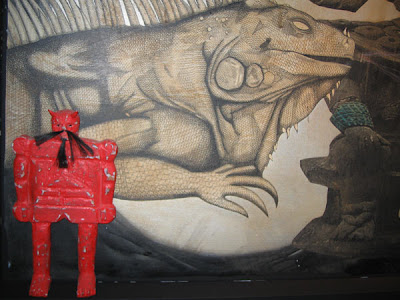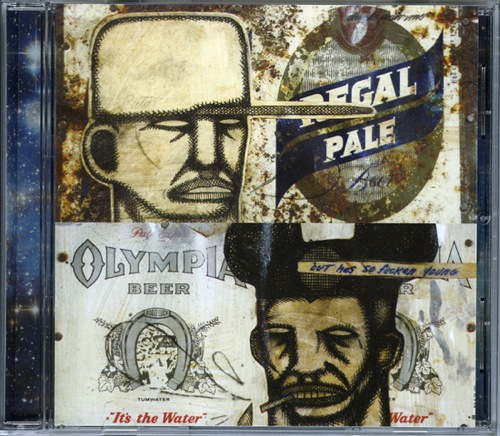Thursday, 16 December 2010 13:30 |
By Susie Lee |
 Last weekend, we attended the opening of the Date Farmers' show at Ace Gallery Los Angeles. Today, we have an exclusive feature essay on the exhibition and the works themselves, written by contributing author Susie Lee. —Juxtapoz Web Staff
Last weekend, we attended the opening of the Date Farmers' show at Ace Gallery Los Angeles. Today, we have an exclusive feature essay on the exhibition and the works themselves, written by contributing author Susie Lee. —Juxtapoz Web Staff
It’s no secret that underground art is currently invading the high art world at an alarming rate. With Retna and Barry McGee being named two of Esquire Magazine’s top 5 artists to see at Basel Miami this year, it’s evident that galleries, museums, and collectors are scrambling to be the first to snatch up the underground scene’s next big thing. Low art is becoming high art, and what used to interest big collectors is now becoming a bit of the same old boring game.
One of the best examples of this changing of the guard was seen at the long anticipated Date Farmers opening this Saturday at Ace Gallery. Many were pleasantly surprised to hear that one of the biggest galleries in L.A. had picked up the street culture-inspired underground art duo. Ace Gallery is one of the longest running and most reputable galleries in Los Angeles, and compared to their star-studded roster of museum veterans, underground artists like the Date Farmers seem like quite the radical leap.

But upon taking a close look at the Date Farmers work, it’s not hard to see what it is about their art that appeals to a mega-gallery like this one. One of the duo’s signature elements is their use of discarded corrugated metal signs, found and brought over by the artists from across the border in Mexico. They seamlessly pair these hand-painted signs with found objects and their own text and imagery, creating humorous juxtapositions and altering its meaning, often with satire and subtle social commentary. Their use of found objects like bottle caps, children’s toys, hand-written notes, and newspaper cut-outs are not all that different from the Rauchenbergs you might see hanging in a museum. And their use of pop-culture imagery and corporate logos is reminiscent of the pop art of Andy Warhol, which you could see selling for millions of dollars at an auction house. In many ways, the Date Farmers have a lot more in common with these guys than some of their contemporaries.
But that alone isn’t enough to grab the attention of a powerful man like Ace Gallery’s founder, Douglas Christmas. The Date Farmers offer something new and enticing for a high art world that is catching on like wildfire to a burgeoning underground art explosion. They combine these historically influential techniques with elements of an underground culture that is far removed from the museums, auction houses, and higher echelons of art: street art, tattoo culture, comic book imagery, and of course, cholos.

But to people who are already familiar with underground art and culture, this is nothing new. There is a lot more to the Date Farmers that sets them apart from others in the scene. One element that is distinctly Date Farmers is their power to take you away to a foreign, yet familiar place. The found signs, their warm color palette, and their elaborately cross-hatched illustrations of desert imagery (snakes, tarantulas, coyotes, and skulls) invokes their hometown of Indio, as well as the desert landscape in Mexicali and Oaxaca, where they retrieve some of their found materials. They give you a feeling of being in a hot desert town that could be somewhere across the border or just down the street. El Mac, an Arizona native, flew out for the show and confirmed “they really capture the warmth and feeling of the Southwest.”
While the Date Farmers work can whisk you away, it also takes you to a personal place. Their common objects, hand-written notes, ticket stubs, and tiny religious images taken from churches glued to the canvas have a way of bringing you to a familiar, personal space. Something in their art may trigger a faint memory of something you once held in your hand but have long since discarded, making you feel like there is a piece of yourself on the canvas somewhere. There is an unmistakable genuineness to their work.



Even their identity as the “Date Farmers” is about as genuine as it gets. Their name is not a metaphor, or a joke, or a play on words. One of the artists, Armando Lerma’s family owned a date farm where Carlos Ramirez, the other half of the duo, worked picking dates. Marsea Goldberg of New Image Art, when asked about why she chose to give them their first show, she said “I chose to work with the Date Farmers because their talent. Their artwork had something very fresh and familiar at the same time. I loved their humor and passion straight off the bat and their anger which never stopped to push and question.”
“I think it’s our job as artists to do this kind of work,” says Armando Lerma. “It’s not art for art’s sake, it’s not meant to be pretty. We do have things that we want to say and… we feel this injustice and all that sort of anti-establishment stuff. That’s where we come from. Representing poor people, it’s just always been our culture. We didn’t ever want to be artists just to make art. It was the message that we wanted to against. And I’m not too sure what the message is but I think there are a lot of messages you can see in the artwork depending on your understanding of what’s going on in the world. But there are so many bad things going on in the world, and I think that we touch upon a lot of those things."

While everyone is wondering whether or not this recent trend towards underground art will have a lasting impact on the greater art market, Marsea Goldberg responds with a confident, “Yes, of course. It is the current wave and will last and find its place in art history. It is art for the people!” For the Date Farmers and all of us in the underground scene, let’s hope so.
More pictures of the new work and from the opening night here. 









































